Words are powerful magic. Finding a word—polyamory—to describe my romantic and sexual relationships made it possible to tell people what I was doing: my friends, my family, my lovers, and most importantly, myself. I was a college dropout when I first encountered the term polyamory, which we’ll define here as the conscious romantic and/or sexual involvement of three or more consenting adults.
The comic book which introduced me to the name of this concept, and which I read so eagerly, has gotten lost somewhere in my forty-plus years of raggle-taggle relocations. Its main character was named Polly, and I think the front cover was mostly black…. At any rate, it left me longing for further literary examples of this newly validated category of human behavior: stories about kissing and hugging and making love with everybody, without guilt or shame. Which I both wrote and found.
Tales of Nevèrӱon by Samuel R. Delany
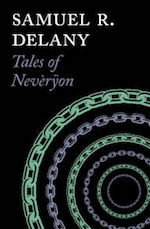 Tales of Nevèrӱon contains one of my favorite polyamorous situations. Obviously thumbing his authorial nose at traditional anthropology’s tendency to reframe other cultures’ practices within its own values, Delany writes of the polygamous Rulvyn from a feminist viewpoint. Among these mountain people, the sage Venn explains, “a strong woman married a prestigious hunter; then another strong woman would join them in marriage—frequently her friend—and the family would grow.” Reversing the conventional interpretation of polygamy’s power dynamic while keeping numbers and gender identical, Delany calls familiar readings of such relationships into question. Yet the brief passage on Rulvyn mores is only one of the many neat tricks he pulls off in this stunning 1979 fantasy, which on its surface is simply another book in the sword-and-sorcery subgenre.
Tales of Nevèrӱon contains one of my favorite polyamorous situations. Obviously thumbing his authorial nose at traditional anthropology’s tendency to reframe other cultures’ practices within its own values, Delany writes of the polygamous Rulvyn from a feminist viewpoint. Among these mountain people, the sage Venn explains, “a strong woman married a prestigious hunter; then another strong woman would join them in marriage—frequently her friend—and the family would grow.” Reversing the conventional interpretation of polygamy’s power dynamic while keeping numbers and gender identical, Delany calls familiar readings of such relationships into question. Yet the brief passage on Rulvyn mores is only one of the many neat tricks he pulls off in this stunning 1979 fantasy, which on its surface is simply another book in the sword-and-sorcery subgenre.
Fledgling by Octavia E. Butler
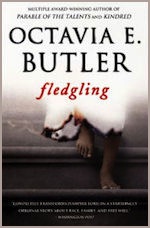 Octavia E. Butler’s last novel, Fledgling, was also ostensibly lighter fare, at least according to the author: a vampire story. Of course it’s something more, because of Butler’s inevitable engagement with problems with gender roles, racial representation, and hierarchy. Heroine Shori Matthews spends the bulk of the book carefully constructing a polyamorous family for her own protection and nourishment. Trading sex and pleasure and improvements to their immune systems for humans’ blood, Shori takes male and female symbionts into her fold. Lots and lots of them—a mentor advises her that eight is a good number of symbionts, and that she should let any jealousies work themselves out without interference. On top of that, her species, which is called the Ina, mate with other Ina in groups, and they live communal yet sex-segregated lives. I so wish Butler had lived to write this 2005 book’s sequels.
Octavia E. Butler’s last novel, Fledgling, was also ostensibly lighter fare, at least according to the author: a vampire story. Of course it’s something more, because of Butler’s inevitable engagement with problems with gender roles, racial representation, and hierarchy. Heroine Shori Matthews spends the bulk of the book carefully constructing a polyamorous family for her own protection and nourishment. Trading sex and pleasure and improvements to their immune systems for humans’ blood, Shori takes male and female symbionts into her fold. Lots and lots of them—a mentor advises her that eight is a good number of symbionts, and that she should let any jealousies work themselves out without interference. On top of that, her species, which is called the Ina, mate with other Ina in groups, and they live communal yet sex-segregated lives. I so wish Butler had lived to write this 2005 book’s sequels.
“«Légendaire.»” by Kai Ashante Wilson
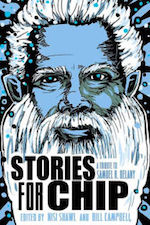 My next recommendation is a bit of a cheat, because it’s a short story rather than a novel. First published in 2013 and reprinted in 2015’s Stories for Chip, “«Légendaire.»” by Kai Ashante Wilson features polyamory as a given, background to a fantastic tale of love and loss and imperious artistic destiny. “When she lies down with her husband or with her wife,” Wilson writes in the story’s fifth paragraph, matter-of-factly introducing us to the group marriage out of which his hero’s born. A few lines later he adds, so there’s no mistaking what’s meant, “Her wife and husband have long since gone to bed.” Such arrangements are not the focus of “«Légendaire.»” but its armature. In this case, the mundanity of multiply-partnered love is balm to my oversensitized, underprivileged heart.
My next recommendation is a bit of a cheat, because it’s a short story rather than a novel. First published in 2013 and reprinted in 2015’s Stories for Chip, “«Légendaire.»” by Kai Ashante Wilson features polyamory as a given, background to a fantastic tale of love and loss and imperious artistic destiny. “When she lies down with her husband or with her wife,” Wilson writes in the story’s fifth paragraph, matter-of-factly introducing us to the group marriage out of which his hero’s born. A few lines later he adds, so there’s no mistaking what’s meant, “Her wife and husband have long since gone to bed.” Such arrangements are not the focus of “«Légendaire.»” but its armature. In this case, the mundanity of multiply-partnered love is balm to my oversensitized, underprivileged heart.
To atone for choosing a short work I’ll recommend a second, bonus story by the same author, from 2014. In “The Devil in America”, Hazel Mae, mother of protagonist Easter, battles off the warped obscenities of an adversary accusing her of promiscuity, the vice most commonly–and mistakenly–associated with the polyamory she has secretly practiced.
The Fifth Season by N.K. Jemisin
 Jemisin’s The Fifth Season, published in 2015, is not only a novel, it’s the beginning of a trilogy. As such, it has the epic scope we expect of longer narratives: it spans countries and civilizations, oracles and ages. Large as life, it depicts horrific disasters on a global scale, and hints at human rights abuses to match. But at a certain point, a revivifying lull in its grim action, it brings together three major characters in a joyful male/female/male ménage à trois. At first awkward and unlooked for, (“‘So you have decided to share?’…She blinks as the words register. ‘Uh?’”) the relationship eventually becomes a source of solid comfort and stability for the witch, wizard, and pirate chief who enter into it. For as long as it lasts.
Jemisin’s The Fifth Season, published in 2015, is not only a novel, it’s the beginning of a trilogy. As such, it has the epic scope we expect of longer narratives: it spans countries and civilizations, oracles and ages. Large as life, it depicts horrific disasters on a global scale, and hints at human rights abuses to match. But at a certain point, a revivifying lull in its grim action, it brings together three major characters in a joyful male/female/male ménage à trois. At first awkward and unlooked for, (“‘So you have decided to share?’…She blinks as the words register. ‘Uh?’”) the relationship eventually becomes a source of solid comfort and stability for the witch, wizard, and pirate chief who enter into it. For as long as it lasts.
Black Wine by Candas Jane Dorsey
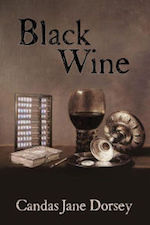 You may have noticed that all four of these recommendations are by authors of African descent. Why? Not because we’re the only ones who write about polyamory in SFF, I’m sure. Nor because that’s all I read. As proof, my fifth recommendation is the 1997 novel Black Wine, by the inimitable–and European-descended–Candas Jane Dorsey. In this—fantasy? fable? far-future science fiction? whatever it is—dirigible sailors formally bond with one another in families of three or more. Five adults is the usual number, and these romantic, sexual, and domestic circles are called, unsurprisingly, “hands,” with individual members known as “fingers.” Slippery as the book’s genre, Dorsey’s depiction of gender, sexuality, and love rides meandering currents through strange lands and interesting times, with the claspings of the sailors’ hands among its happiest moments.
You may have noticed that all four of these recommendations are by authors of African descent. Why? Not because we’re the only ones who write about polyamory in SFF, I’m sure. Nor because that’s all I read. As proof, my fifth recommendation is the 1997 novel Black Wine, by the inimitable–and European-descended–Candas Jane Dorsey. In this—fantasy? fable? far-future science fiction? whatever it is—dirigible sailors formally bond with one another in families of three or more. Five adults is the usual number, and these romantic, sexual, and domestic circles are called, unsurprisingly, “hands,” with individual members known as “fingers.” Slippery as the book’s genre, Dorsey’s depiction of gender, sexuality, and love rides meandering currents through strange lands and interesting times, with the claspings of the sailors’ hands among its happiest moments.
None of these recommendations are “about” polyamory. More accurately, these stories are around polyamory: loving everybody figures into what they’re about in different ways—as an exception, as a cultural marker for travelers in time and space, as a signifier of civility and sophistication, and so on. I’m sure that a thorough search would provide at least as many examples of ways of portraying polyamory in SFF as there are of practicing it.
Take my suggestions. Read them. Read my work as well, for you’ll find that, as I noted earlier, I’ve definitely written polyamory into several of the worlds I’ve imagined. And add your recommendations to mine in the comments below. There’s no reason to stop with five, is there? Our hearts and our minds can hold more.
Top image: Game of Thrones (2011- )
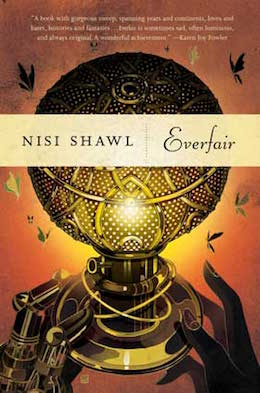 Nisi Shawl is a writer of science fiction and fantasy short stories and a journalist. She is the author of Everfair (Tor Books, September 6) and co-author (with Cynthia Ward) of Writing the Other: Bridging Cultural Differences for Successful Fiction. Her short stories have appeared in Asimov’s SF Magazine, Strange Horizons, and numerous other magazines and anthologies.
Nisi Shawl is a writer of science fiction and fantasy short stories and a journalist. She is the author of Everfair (Tor Books, September 6) and co-author (with Cynthia Ward) of Writing the Other: Bridging Cultural Differences for Successful Fiction. Her short stories have appeared in Asimov’s SF Magazine, Strange Horizons, and numerous other magazines and anthologies.









